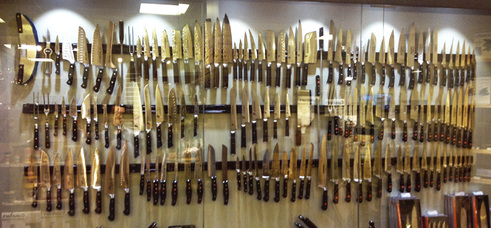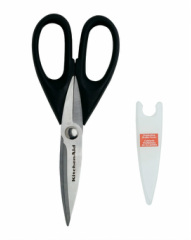Those four knives are:
- 8" Chef's Knife
- Paring Knife
- Serrated Bread Knife
- Kitchen Shears
Ok, so maybe it's three knives, and one pair of sorta knives, but with these four tools, you will be well prepared to start slicing, dicing, mincing, and more. Let's look into these in more detail.
When looking for knives, you may be overwhelmed by the sheer number and variety that's available out there.
The chef's knife was named for the fact that it is chef's best friend in the kitchen. Well, maybe that isn't true, but it might as well be. I throw word "workhorse" around about as liberally as Paula Deen does butter in the dessert episode of Paula's Home Cooking, but this knife really will be the workhorse of your team. 8 inches is the ideal size for almost anything you will tackle, whether that be veggies, chicken breasts, or even a watermelon. Bigger, and it will be unwieldy for when you need to do fine mincing, and smaller and you may not have the heft or length you need to cleanly cut through some noms.
When buying a chef's knife, you are looking for a few main qualities: heft, balance, and comfort in your hand.
Pick up a cheap $10 chef's knife at Wal Mart or from the kitchen tools section of your local supermarket and you will notice how light it is. That's because the blade itself is thin and the handle is probably cheap plastic. It may seem strange that a thicker blade is desirable in a knife. I mean, wouldn't a thinner blade cut more easily through food? Not always. A knife needs to be sharp and stay sharp at one important side - the cutting edge. Heavier, sturdier knives will typically hold that sharp edge longer. Quality knives may seem unusually thick at the spine, the top edge that runs opposite the curved edge, but that is where the weight comes in. The extra weight will mean that you have to put less effort in when slicing and chopping, and the extra mass will also help when you're dealing with a thicker or tougher food. This doesn't mean that you should go out and buy the heaviest knife that you can find, but don't be afraid if your knife isn't in the featherweight category.
Balance and comfort in your hand go, well, hand in hand. When holding a knife in your hand, you shouldn't feel like the blade is trying to drag you down. The weight of a knife should be just barely biased towards the blade. This will make it more comfortable to use in the long run. Comfort in hand is a bit more subjective. There are many handle designs to suit all tastes - some like rounder handles and some like ones which are more squared off. This is up to you.
The paring knife proves that it isn't the size of the blade that matters, it's how you use it. That said, a paring knife comes in a surprisingly large amount of sizes for what is supposed to be a "small" knife. In general, a 3.5-4 inch paring knife is what you should be looking for. What will you be using a paring knife for? Well, there will be times when a large chef's knife is simply too unwieldy or unnecessarily large for the job. Peeling fruit and slicing avocados in the peel are just some of the uses of this small but powerful player. Plus, this can also double as a cheese serving knife in a pinch the next time you have a fancy party.
The same rough rules apply for the paring knife as does for the chef's knife. Of course it will be lighter since it is much smaller, but a nice paring knife should still feel hefty for its size. As before, make sure the handle feels comfortable in your hand.
The bread knife will be the only major serrated (ridged with teeth) knife in your major knife arsenal. If you have ever tried to cut into a nice, soft piece of bread with even the sharpest chef's knife, you will end up smashing it. This is why the serrated edge of a bread knife is necessary. The good thing is, despite being called a bread knife, it is way more versatile than that. It works wonders on tougher skinned fruit such as cantaloupe and pineapple and it can do double duty as a carving knife in a pinch.
An 8-10" bread knife would the best range to work with. Heft and comfort will be the key drivers in deciding the best knife to get. Balance will be a bit trickier due to the odd shape of the knife, but the more balanced you can get it, the better.
Yes, yes. Shears are not really what you would think of when it comes to knives, but what are scissors but two knives hinged together? A dedicated pair of kitchen shears is very useful. From cutting a fresh or roasted chicken to snipping herbs, investing in a pair of heavy-duty shears will make your cooking experience that much easier and more fun. Plus, nothing will tear through that annoying plastic clamshell packaging like a pair of kitchen shears will. See! It's versatile! Do make sure the blades are stainless steel and the handles comfortably fit your hand.
There is generally one key rule when it comes to knife care. Never, and I really mean it, machine wash your knives. Machine washing is too aggressive for knife handles and being banged around by the water jets can dull a knife over time. What, did you think a dish washer was gentle? Those water jets are intense.
Storing your knives can be done in a few ways. If you must keep your knives in a drawer, I would suggest getting blade covers for at least your chef and paring knives. They will ensure the smooth cutting edge does not get banged up and dull. Another option, and one that looks really cool, is to use a magnetic knife bar. This will keep knives from bumping into each other, display your tools proudly, and you get to look like a badass every time you whip a knife off the wall.
Brands and Shopping
There are many brands of knives out there. Everything from high-end brands like J.A. Henkels and Wusthof to less prestigious ones are out there. Just because a knife is more expensive does not necessarily mean it is better. It is important to try your best to try out and hold a knife before buying. That said, most stores don't want people to be able to freely swing knives around in public.
What about Knife Sets?
You may be asking, "Why don't I just buy one of those block sets? They have everything I need and even come with a nice holder!" True, knife sets can be quite convenient. The reason I focus on giving a piece-by-piece breakdown of key tools is because sometimes you don't have the need for a 24 or 48 piece knife block set. Mastering a few key pieces will be more useful than playing around with fun but otherwise not very useful tools. If you find a set that has all the knives I mentioned here and meets all the recommendations and you can afford the full set, more power to you! However, if you choose not to get a set for cost reasons or just because you don't want to keep track of over a dozen knives, the three mentioned above will get you through thick and thin.
Cutting Boards
With your new knives, you also will need a cutting board (or a few!) to cut your food on. Wood cutting boards are pretty, but usually require special care and are difficult to clean and expensive. Plastic, while not as glamorous, is the practical way to go, especially if you're building up your kitchen from the ground up. In order to prevent cross contamination, a topic we will discuss in a later post (hint, it's a bad thing!), and for practicality's sake, having multiple cutting boards of different sizes can let you work on multiple things at once. Plastic is also typically dishwasher safe which makes clean-up a breeze. My main recommendation with choosing a cutting board is to find ones that are thick and sturdy. Flexible cutting boards, while seeming practical, too easily get worn down, warp, and become unusable.






